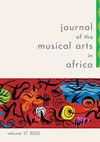The use of symbols in the praise-naming of chiefs in selected Igbo folk music
IF 0.2
4区 艺术学
0 MUSIC
引用次数: 1
Abstract
Abstract Praise names are repositories and means through which ideologies and socio-cultural identities are transmitted in Igbo culture. In ‘praise naming’, symbols with socio-cultural meanings are deployed to represent ideological realities of Igbo naming in communities. The symbols which are infused with the Igbo beliefs of philanthropy and display levels of stratification have not been subjected to adequate linguistic studies. This study, therefore, undertakes a critical appraisal of the strategic deployment of symbols in praise naming chiefs in selected folk songs of two popular and foremost Igbo folk musicians with a view to uncovering the underlying ideological meanings and significance of the symbols. Analysing the data through the lens of Martin and White’s appraisal theory reveals that symbols derived from five sources – plants, animals, nature, body parts and deities – construct the chiefs in terms of five images of God as protector, benefactor, saviour, dreaded being and as the almighty. While the plant symbols conceptualise chiefs as impartial and all-round providers, the animal and god symbols represent them as supreme and as inspiring dread. The nature symbols depict them as unquantifiable, while body parts represent them as rescuers. These culturally-based symbols, which have both positive and negative connotations, have generally reconstructed the rich as gods of the poor in the songs.伊博族民间音乐中对首领的褒奖中符号的使用
在伊博文化中,赞美名是意识形态和社会文化身份传播的载体和手段。在“赞美命名”中,使用具有社会文化意义的符号来代表社区中伊博人命名的意识形态现实。这些符号注入了伊博人对慈善事业的信仰,并显示了分层的程度,但这些符号并没有得到充分的语言学研究。因此,本研究对两位最受欢迎的伊博民间音乐家精选的歌曲中符号在赞美首领中的策略运用进行了批判性的评价,以期揭示符号的潜在意识形态含义和意义。通过马丁和怀特的评价理论对数据进行分析,可以发现,来自植物、动物、自然、身体部位和神祇这五种来源的符号,以上帝的五种形象构建了酋长,即上帝是保护者、恩人、救世主、可怕的存在和全能的上帝。植物符号将酋长视为公正和全面的提供者,而动物和神的符号则代表他们至高无上,令人恐惧。自然符号把它们描绘成不可量化的,而身体部位则把它们描绘成救援者。这些文化符号既有积极的内涵,也有消极的内涵,在歌曲中普遍将富人重构为穷人的神。
本文章由计算机程序翻译,如有差异,请以英文原文为准。
求助全文
约1分钟内获得全文
求助全文

 求助内容:
求助内容: 应助结果提醒方式:
应助结果提醒方式:


